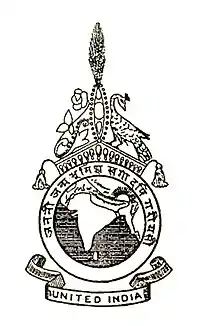Communist Consolidation
Communist Consolidation (1935 – 1938) was an Indian revolutionary and communist organization, founded by Hare Krishna Konar among with other prisoners of the Cellular Jail with the ideology of Marx and Lenin's theory Marxism–Leninism. It was the largest resistance group against British rule in the Jail, this organization also led the historical 36-days hunger strike in 1937 where the British government had to bow before the demands of the political prisoners.[1]
Communist Consolidation कम्युनिस्ट समेकन | |
|---|---|
| Spokesperson | Shiv Verma Hare Krishna Konar |
| Founder | Hare Krishna Konar |
| Founded | 26th April 1935 at Andaman, Cellular Jail |
| Dissolved | 1938 |
| Merged into | Communist Party of India |
| Headquarters | Cellular Jail, Port Blair, Andaman and Nicobar Islands, (up to 1947) |
| Newspaper | "The Call" |
| Membership | |
| Ideology | |
| Political position | Left-wing |
| Colors | Red |
| Slogan | "Inquilab Zindabad" "Duniya ke Mazdooron ek ho" |
| Anushilan Samiti |
|---|
 |
| Influence |
| Anushilan Samiti |
| Notable events |
| Related topics |
History (Before 1935)
The history of Communist Consolidation is older than, when the group was formed in 1935. On 12 May 1933, some of the prisoners of Cellular Jail gathered and started a hunger strike, causing the deaths of Mahavir Singh, Mohan Kishore Namadas, and Mohit Moitra. The British Raj acceded to the demands of the freedom fighters to stop the hunger strike and finally after 46 days hunger strike end on 26 June 1933.
Formation in 1935
In 1935, Communist Consolidation was founded by 39 inmates, but the main mastermind to form this group was Hare Krishna Konar. The maximum of its members belong to the minority tendency of the Marxist and Communist or Jugantar part of Anushilan Samiti. Although this was a secret revolutionary group and the members of this organization swelled higher and higher.[2][3]
They started a study circle named "A Veritable University of Freedom Fighters" and this group also started to teach about the principles of Socialism, Marxism and Communism were explained, how October Revolution happened who was Karl Marx, Friedrich Engels and finally in year 1936 the members of this organization claimed that they were fighting to uproot British Raj as well as to make the country totally Communist Country.[3]
They only used the Class Struggle and Political Slogan “The “Inquilab Zindabad” and “Duniya ke Mazdooron ek ho” because they claimed that at first they were Nationalist Prisoners but after the formation of Communist Consolidation and reading about the principal of Socialism, Marxism and Communism they started believing themself as a Political Prisoners.[4][5]
Second Hunger Strike
The long hunger-strike movement in the Andamans in July and August 1937, led by the Communists, marked an important phase in India's national struggle. As nine-tenths of the total convicts in Andaman were from Bengal, the hunger strike of Andaman prisoners caused widespread outrage in Bengal where a strong movement for the release of political prisoners began.
Members
The organization's membership expanded rapidly to more than 800 inmates.
Some of the members were:
- Hare Krishna Konar, Founder of this organization, in April 1935[6]
- Niranjan Sengupta
- Sudhangshu Dasgupta
- Nalini Dasgupta
- Shiv Verma
- Ganesh Ghosh
- Batukeshwar Dutt[7]
- Jaidev Kapoor
- Ambika Chakrabarty
- Satish Prakrashi
- Sachindra Nath Sanyal
- Biplabi Dhruvesh Chattopadhyay
- Ananta Chakroborty
- Subodh Roy
- Bejoy Kumar Sinha
- Fakir Sen
- Manmath Nath Gupta
- Kalipada Chakrabarty
- Lalmohan Sen
See also
References
- Sanyal, Sachindranath (1 January 2017). Bandi Jeevan (in Hindi). Sachindra Nath Sanyal. ISBN 978-8184408973.
- Majumdar, Ramesh Chandra (1975). Penal Settlement in Andamans. Delhi: Government of India. p. 339.
- "History of Andaman Cellular Jail". Andaman Cellular Jail. Archived from the original on 13 January 2007. Retrieved 10 February 2022.
- Saha, Murari Mohan (2001). Documents of the Revolutionary Socialist Party. Agartala: Lokayata Chetana Bikash Society. p. 21.
- "The legend who survived Saaza-E-Kaalapani". www.tripurainfo.com. 11 March 2007. Archived from the original on 11 March 2007. Retrieved 10 February 2022.
- "Revolutionaries: Section 'K'". Andaman Cellular Jail. Archived from the original on 14 July 2006. Retrieved 10 February 2022.
- "Revolutionaries: Section 'D'". 3 May 2006. Archived from the original on 3 May 2006. Retrieved 10 February 2022.